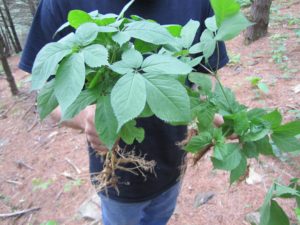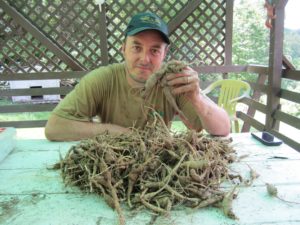Ginseng: An Option for Underutilized Forest Land in the West
go.ncsu.edu/readext?637787
en Español / em Português
El inglés es el idioma de control de esta página. En la medida en que haya algún conflicto entre la traducción al inglés y la traducción, el inglés prevalece.
Al hacer clic en el enlace de traducción se activa un servicio de traducción gratuito para convertir la página al español. Al igual que con cualquier traducción por Internet, la conversión no es sensible al contexto y puede que no traduzca el texto en su significado original. NC State Extension no garantiza la exactitud del texto traducido. Por favor, tenga en cuenta que algunas aplicaciones y/o servicios pueden no funcionar como se espera cuando se traducen.
Português
Inglês é o idioma de controle desta página. Na medida que haja algum conflito entre o texto original em Inglês e a tradução, o Inglês prevalece.
Ao clicar no link de tradução, um serviço gratuito de tradução será ativado para converter a página para o Português. Como em qualquer tradução pela internet, a conversão não é sensivel ao contexto e pode não ocorrer a tradução para o significado orginal. O serviço de Extensão da Carolina do Norte (NC State Extension) não garante a exatidão do texto traduzido. Por favor, observe que algumas funções ou serviços podem não funcionar como esperado após a tradução.
English
English is the controlling language of this page. To the extent there is any conflict between the English text and the translation, English controls.
Clicking on the translation link activates a free translation service to convert the page to Spanish. As with any Internet translation, the conversion is not context-sensitive and may not translate the text to its original meaning. NC State Extension does not guarantee the accuracy of the translated text. Please note that some applications and/or services may not function as expected when translated.
Collapse ▲As most of our perennial plants have settled in for the ‘long winters nap,’ now is a perfect time to consider if growing wild-simulated ginseng (or other forest herbs) may be a viable option for your wooded property…especially if you live in the western part of the state.
With current timber prices and increasing value placed on aesthetics, diversification, and alternatives to timber harvesting, there is a lot of underutilized forestland in the western part of the state that could be considered for production of medicinal herbs in a “forest farming” system. In the mountains and foothills of western North Carolina, the colder winters, ample rainfall, good drainage, and prevalence of rich cove forests, create the ideal climate and environment for ginseng and other medicinal forest herbs. American ginseng (Panax quinquefolius) has the most well-known (notorious, some might say) reputation and is the most sought after of our native forest medicinal plants.

Photo courtesy of Jim Hamilton
If you own mature forestland (or even a nice wooded backyard) in the foothills or the mountains, with good soil and drainage, ginseng may be a viable way to diversify your property and produce a forest-farmed ‘crop’ in your underutilized woods. Ginseng is a native medicinal plant whose roots have been wild-harvested in the mountains for centuries to export to Asia for their purported health and energy benefits.
Ginseng roots harvested from the southern Appalachians of North Carolina historically have been prized for their shape, quality, and “character” by the export markets. While it can be a tricky plant to grow successfully, over the last 6 years, prices for wild & wild-simulated ginseng have fluctuated from between $500 to $1100 per dried pound. Increasingly, there is also interest from domestic markets and consumers, as well as herbal pharmaceutical companies, who are seeking to capture & create additional outlets for verified & sustainably grown forest herbal products.
However, growing ginseng beyond the hobbyist level is not for the faint of heart. Ginseng takes between 7 to 10 years or more to reach a size favored by the markets to which it is most commonly exported. When planted at any density, voles, deer, disease, and thieves become daunting challenges for large-scale cultivation. However, it can be done…with an ample supply of sweat equity, vigilance, and patience…and a good planting site.
Ginseng prefers shady, older-growth forests. There are a number of companion plants that it can be commonly found within the wild that are also indicators of a good site. If you’ve noticed other herb species like trillium, ramps, bloodroot, blue & black cohosh, maiden-hair fern, and jack-in-the-pulpit on your property, you probably have an excellent site to try your hand at growing ginseng. While cove forest stands dominated by older yellow-poplar and sugar maple are the ideal forest-types under which to grow ginseng, some forest farmers in western North Carolina have had good luck under older-growth white pine stands as well. The rich, tilth of decomposing needle mulch makes for a great planting/growing environment.
If your woods fit this ‘menu’ of prime forest-herb-growing site characteristics, all you need is some site prep labor (clearing downed branches and rocks), a rake, and some seed—and more labor to get it planted. Site scouting & identification and clearing can take place throughout the year, but Fall is the typical planting season for ginseng.
Currently, there is not a reliable North Carolina source of ginseng seed for producers and landowners interested in cultivating this forest-grown specialty crop at any large scale. While some local outlets exist for seed for hobbyist level production (no more than a few ounces), most ginseng seed available commercially from online or social media ‘interest pages’ comes from large-scale, field-cultivated ginseng farms in Wisconsin and Ontario, Canada. Some internet sources advertise this seed from $50-$80 per pound. Higher quality seed from ‘woods grown’ operations can average in price from $125-$200 per pound, but often, obtaining larger quantities of high-quality seed is difficult. Planting rates can vary from a few ounces to several pounds per acre, depending on the investment (and risk) that the landowner is willing to make.

Photo courtesy of Jim Hamilton
Dr. Jim Hamilton, County Extension Director for Watauga County, has been offering wild-simulated ginseng production workshops over the last 6 years during September and October. If you’re interested in considering ginseng or other forest herbs to diversify production in your underutilized forest lands, you can contact him at: jim_hamilton@ncsu.edu
Additionally, Dr. Jeanine Davis’s book, “Growing and Marketing Ginseng, Goldenseal, and Other Woodland Medicinals”, is an excellent guide to the production of these and other forest herbs.


